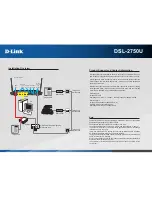
VLANs and Your Switch
87
■
VLANs help to control traffic
With traditional networks, congestion can be caused by broadcast
traffic that is directed to all network devices whether they require it or
not. VLANs increase the efficiency of your network because each
VLAN can be set up to contain only those devices that need to
communicate with each other.
VLANs and Your
Switch
Your Switch provides support for VLANs using the IEEE Std 802.1Q-1998.
This standard allows traffic from multiple VLANs to be carried across one
physical link.
The IEEE Std 802.1Q-1998 allows each port on your Switch to be placed
in:
■
Any one VLAN defined on the Switch.
■
Several VLANs at the same time using 802.1Q tagging.
The standard requires that you define the following information about
each VLAN on your Switch before the Switch can use it to forward traffic:
■
VLAN Name
— This is a descriptive name for the VLAN (for example,
Marketing or Management).
■
802.1Q VLAN ID
— This is used to identify the VLAN if you use
802.1Q tagging across your network.
The Default VLAN
A new or initialized Switch contains a single VLAN, the Default VLAN.
This VLAN has the following definition:
■
VLAN Name
— Default VLAN
■
802.1Q VLAN ID
— 1 (if tagging required)
All the ports are initially placed in this VLAN, and it is the only VLAN that
allows you to access the management software of the Switch over the
network.
Communication
Between VLANs
If the devices placed in a VLAN need to communicate to devices in a
different VLAN, a router or Layer 3 switching device with connections to
both VLANs needs to be installed. Communication between VLANs can
only take place if they are all connected to a routing or Layer 3 switching
device.
Summary of Contents for 3C17203 - SuperStack 3 Switch 4400
Page 8: ...GLOSSARY INDEX ...
Page 14: ...14 ...
Page 26: ...26 CHAPTER 1 SWITCH FEATURES OVERVIEW ...
Page 44: ...44 CHAPTER 3 USING MULTICAST FILTERING ...
Page 55: ...How STP Works 55 Figure 13 STP configurations ...
Page 58: ...58 CHAPTER 4 USING RESILIENCE FEATURES ...
Page 84: ...84 CHAPTER 7 STATUS MONITORING AND STATISTICS ...
Page 92: ...92 CHAPTER 8 SETTING UP VIRTUAL LANS ...
Page 98: ...98 CHAPTER 9 USING WEBCACHE SUPPORT ...
Page 120: ...120 CHAPTER 12 POWER MANAGEMENT AND CONTROL ...
Page 122: ...122 ...
Page 126: ...126 APPENDIX A CONFIGURATION RULES ...
Page 134: ...134 APPENDIX B NETWORK CONFIGURATION EXAMPLES ...
Page 150: ...150 GLOSSARY ...
















































